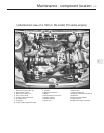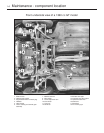
Maintenance schedule 1•3
1
Every 250 miles (400 km) or weekly
ⅥⅥ Refer to “Weekly checks”.
Every 36 000 miles (58 000 km) or
3 years - whichever comes sooner
In addition to all the items listed above, carry out the following:
ⅥⅥ Renew the timing belt (Section 31).
Note: Although the normal interval for timing belt renewal is 72 000
miles (120 000 km), It is strongly recommended that the timing belt
renewal interval is halved to 36 000 miles (60 000 km) on vehicles
which are subjected to intensive use, ie. mainly short journeys or a lot
of stop-start driving. The actual belt renewal interval is therefore very
much up to the individual owner, but bear in mind that severe engine
damage will result if the belt breaks.
Every 6000 miles (9000 km) or
6 months - whichever comes sooner
In addition to all the items listed above, carry out the following:
ⅥⅥ Renew the engine oil and filter (Section 3)*.
ⅥⅥ Check the condition of the front brake pads, and renew if
necessary (Section 4).
ⅥⅥ Check the automatic transmission fluid level and top-up if
necessary (Section 5).
Note: Renewal of the engine oil filter at this service interval is only
necessary on models fitted with the XU9J1/L engine and automatic
transmission. On all other models, oil filter renewal is recommended
at every second oil change (ie 12 000 miles/12 months).
Every 48 000 miles (80 000 km) or
4 years - whichever comes sooner
ⅥⅥ Renew the fuel filter - fuel injection models (Section 32).
Every 12 000 miles (18 000 km) or
12 months - whichever comes sooner
In addition to all the items listed above, carry out the following:
ⅥⅥ Check all underbonnet components and hoses for fluid leaks
(Section 6).
ⅥⅥ Renew the spark plugs (Section 7).
ⅥⅥ Check, adjust and lubricate the throttle and choke cables
(Section 8).
ⅥⅥ Check the condition of the auxiliary drivebelt, and renew if
necessary (Section 9).
ⅥⅥ Check the clutch pedal stroke adjustment (Section 10).
ⅥⅥ Check the condition of the seat belts (Section 11).
ⅥⅥ Lubricate the locks and hinges (Section 12).
ⅥⅥ Check the condition of the rear brake shoes and renew if
necessary - rear drum brake models (Section 13).
ⅥⅥ Check the condition of the rear brake pads and renew if
necessary - rear disc brake models (Section 14).
ⅥⅥ Check the operation of the handbrake (Section 15).
ⅥⅥ Inspect the underbody and the brake hydraulic pipes and hoses
(Section 16).
ⅥⅥ Check the condition of the fuel lines (Section 16).
ⅥⅥ Check the condition and security of the exhaust system (Section 17).
ⅥⅥ Check the condition of the exterior trim and paintwork (Section 18).
ⅥⅥ Check the headlight beam alignment (Section 19).
ⅥⅥ Check the operation of the air conditioning system (Section 20).
Every 72 000 miles (120 000 km)
In addition to all the items listed above, carry out the following:
ⅥⅥ Renew the timing belt (Section 31).
Note: This is the interval recommended by Peugeot, but we
recommend that the belt is changed more frequently, at 36 000 miles
(60 000 km) - see above
Every 24 000 miles (36 000 km) or
2 years - whichever comes sooner
In addition to all the items listed above, carry out the following:
ⅥⅥ Check the manual transmission oil level, and top-up if necessary
(Section 21).
ⅥⅥ Renew the manual transmission oil (pre-1988 BE1 transmissions
only) (Section 22).
ⅥⅥ Renew the automatic transmission fluid (Section 23).
ⅥⅥ Check the condition of the driveshaft bellows (Section 24).
ⅥⅥ Check the steering and suspension components for condition
and security (Section 25).
ⅥⅥ Renew the air cleaner filter element (Section 26).
ⅥⅥ Check the ignition system (Section 27).
ⅥⅥ Check the idle speed and mixture adjustment (Section 28).
ⅥⅥ Check the condition of the emissions control system hoses and
components (Section 29).
ⅥⅥ Carry out a road test (Section 30).
Every 2 years (regardless of mileage)
ⅥⅥ Renew the coolant (Section 33).
ⅥⅥ Renew the brake fluid (Section 34).
The maintenance intervals in this manual
are provided with the assumption that you,
not the dealer, will be carrying out the work.
These are the average maintenance intervals
recommended for vehicles driven daily under
normal conditions. Obviously some variation
of these intervals may be expected depending
on territory of use, and conditions
encountered. If you wish to keep your vehicle
in peak condition at all times, you may wish to
perform some of these procedures more
often. We encourage frequent maintenance
because it enhances the efficiency,
performance and resale value of your vehicle.
If the vehicle is driven in dusty areas, used
to tow a trailer, driven frequently at slow
speeds (idling in traffic) or on short journeys,
more frequent maintenance intervals are
recommended.


















